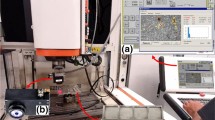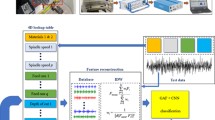Abstract
Inconsistent edges of mechanical workpieces in the same batch are one of the main reasons that lead to different machining performance. A full recognition of the inconsistent features has significant impact on enhancement of their intelligent machining ability. An intelligent hybrid strategy is proposed for edge inconsistent feature detection by machine vision, in which deep learning is combined with variable geometric model together to conduct the function. A deep convolutional neural network based feature classification model is established with K-Means clustering tactic. Supported on the classification model, a variable geometric model for specific edge inconsistency is given with an inconsistency evaluation function to investigate the match degree between the geometric model and the actual detected edge, and then particle swarm optimization algorithm is applied to find the solution of this geometric model. Detection experiments are carried out on a domestic servo-driven vision measuring platform to verify the performance of the proposed approach. The results show that the combined scheme can classify the different type of geometric contour of edge features with 100% correctness, and better evaluation performance by dice similarity index and Hausdorff distance in comparisons with other recent candidate methodologies. It is also indicated that the presented method provides a good recognition of the geometrical shape with less than 0.06mm maximum error for workpiece with 142 × 119mm size in the visual field.















Similar content being viewed by others
References
Qiu H, Li Y, Li Y, new method A (2001) device for motion accuracy measurement of NC machine tools part 2: device error identification and trajectory measurement of general planar motions. Int J Mach Tools Manuf 41(4):535–554
Zhang Y, Lefebvre D, Li QL (2017) Automatic detection of defects in tire radiographic images. IEEE Trans Autom Sci Eng 14(3):1378–1386
Thongkamwitoon T, Muammar H, Dragotti PL (2015) An image recapture detection algorithm based on learning dictionaries of edge profiles. IEEE Trans Inform Forens Secur 10(5):953– 968
Chong Y, Song YH, Zhang YL (2016) Scene text localization using edge analysis and feature pool. Neurocomputing 175:652–661
Chen TJ, Wang Y, **ao CY, Wu QMJ (2016) A machine vision apparatus and method for can-end inspection. IEEE Trans Instrum Measur 65(9):2055–2066
Liu HW, Yin JP, Luo XD, Zhang SC (2018) Foreword to the special issue on recent advances on pattern recognition and artificial intelligence. Neural Comput Appl 29(1):1–2
Fan J, Wang J (2018) A two-phase fuzzy clustering algorithm based on neurodynamic optimization with its application for PolSAR image segmentation. IEEE Trans Fuzzy Syst 26(1):72–83
Kusakunniran W, Wu Q, Ritthipravat P (2018) Hard exudates segmentation based on learned initial seeds and iterative graph cut. Comput Methods Programs Biomed 158:173–183
Tsai DM, Hsieh YC (2017) Machine vision-based positioning and inspection using expectation-maximization technique. IEEE Trans Instrum Meas 66(11):2858–2868
Han Y, Wu YB, Cao DH (2017) Defect detection on button surfaces with the weighted least-squares model. Front Optoelectron 10(2):151–159
Michal S, Bartosz P, Marcin M (2016) Machine vision micro-milling tool wear inspection by image reconstruction and light Ref12ectance. Precis Eng 44:236–244
Guo G, Wang Y, Jiang TT (2014) A shape reconstructability measure of object part importance with applications to object detection and localization. Int J Comput Vis 108(3):241–258
Shahabi HH, Ratnam MM (2010) Prediction of surface roughness and dimensional deviation of workpiece in turning: a machine vision approach. Int J Adv Manuf Technol 48(1-4):1213–1226
Cano T, Chapelle F, Lavest JM, Ray P (2008) A new approach to identifying the elastic behaviour of a manufacturing machine. Int J Mach Tools Manuf 48(14):1569–1577
Koroglu MT, Passino KM (2014) Illumination balancing algorithm for smart lights. IEEE Trans Control Syst Technol 22(2):557–567
Wang JJ, Ma YL, Zhang L, Gao RX, Wu DZ (2018) Deep learning for smart manufacturing: methods and applications. J Manuf Syst 48:144–156
Fujita H, Cimr D (2019) Decision support system for arrhythmia prediction using convolutional neural network structure without preprocessing. Appl Intell 49:3383–3391. https://doi.org/10.1007/s10489-019-01461-0
Zhou F, Yang S, Fujita H, et al. Deep learning fault diagnosis method based on global optimization GAN for unbalanced data. Knowledge-Based Systems, https://doi.org/10.1016/j.knosys.2019.07.008
Park JK, Kwon BK, Park JH, Kang DJ (2016) Machine learning-based imaging system for surface defect inspection. Int J Precis Eng Manuf-Green Technol 3(3):303–310
Zhou SF, Shen W, Zeng D (2016) Spatial-temporal convolutional neural networks for anomaly detection and localization in crowded scenes. Signal Process: Image Commun 47:358–368
Hu ZL, Tang JS, Wang ZM, Zhang K, Zhang L (2018) Deep learning for image-based cancer detection and diagnosis a survey. Pattern Recogn 83:134–149
Wen CB, Liu PL, Ma WB (2018) Edge detection with feature re-extraction deep convolutional neural network. J Vis Commun Image Represent 57:84–90
Diao WH, **an S, Dou FZ, Yan ML, Wang H, Fu K (2015) Object recognition in remote sensing images using sparse deep belief networks. Remote Sensing Lett 6(10):745–754
Chowdhury A, Kautz E, Yener B (2016) Image driven machine learning methods for microstructure recognition. Comput Mater Sci 123:176–187
Liu L, Fieguth P, Guo Y (2017) Local binary features for texture classification: taxonomy and experimental study. Pattern Recogn 62:135–160
Sarkar S, Venugopalan V, Reddy K (2017) Deep learning for automated occlusion edge detection in RGB-D frames study. J Signal Process Syst Signal Image Video Technol 88:205–217
Zhang XS, Gao T, Gao DD (2018) A new deep spatial transformer convolutional neural network for image saliency detection. Des Autom Embed Syst 22(3):243–256
Hoang ND, Nguyen QL, Tran VD (2018) Automatic recognition of asphalt pavement cracks using meta heuristic optimized edge detection algorithms and convolution neural network. Autom Constr 94:203–213
Zhu ZX, Rao C, Bai S, Latecki LJ (2019) Training convolutional neural network from multi-domain contour images for 3D shape retrieval. Pattern Recogn Lett 119:41–48
Mao YH, Shen JJ, Gui XL (2018) A study on deep belief net for branch prediction. IEEE Access 6 (99):10779–10786
Gu JX, Wang ZH, Jason K, Ma LY, Amir S, Bing S, Liu T, Wang XX, Wang G (2015) Recent advances in convolutional neural networks. Comput Sci 77:354–377
LeCun Y, Bengio Y, Hinton G (2015) Deep learning. Nature 521:436–444
Bengio Y (2009) Deep learning architectures for AI. Found Trends Mach Learn 2(1):1–127
Chen LH, Xu ZS, Wang H, Liu SS (2016) An ordered clustering algorithm based on K-means and the PROMETHEE method. Int J Mach Learn Cybern 9(6):1–10
Hu YC, Huan C, Nian FD, Wang Y, Li T (2016) Dense crowd counting from still images with convolutional neural networks. J Vis Commun Image Represent 38:530–539
Zhou W, **e JH, Li GP, Yuan YS (2017) High-precision estimation of target range, radial velocity, and azimuth in mechanical scanning LFMCW radar. IET Radar Sonar Navigation 11(11):1664–1672
Li HL, Meng FM, Luo B, Zhu SY (2014) Repairing bad co-segmentation using its quality evaluation and segment propagation. IEEE Trans Image Process Publ IEEE Signal Process Soc 23(8):3545–3559
Li S, Cheng C (2017) Particle swarm optimization with fitness adjustment parameters. Comput Industr Eng 113:831–841
Kuo YL, Tai CW (2015) A simple and efficient median filter for removing high-density impulse noise in images. Int J Fuzzy Syst 17(1):67–75
Gao YY, Hu HM, Li B (2018) Naturalness preserved nonuniform illumination estimation for image enhancement based on retinex. IEEE Trans Multimed 20(2):335–344
Khambampati AK, Liu D, Konki SK, Kim KY (2018) An automatic detection of the ROI using Otsu thresholding in nonlinear difference EIT imaging. IEEE Sensors J 18(12):5133–5142
Suresh S, Lal S (2017) Modified differential evolution algorithm for contrast and brightness enhancement of satellite images. Appl Soft Comput 61:622–641
Wang F, Liu WY, Liu HJ, Cheng J (2018) Additive margin softmax for face verification. IEEE Signal Process Lett 25(7):926–930
Sudan J, Son LH, Raghvendra K, Ishaani P, Florentin S, Long HV (2019) Neutrosophic image segmentation with dice coefficients. Measurement 134:762–772
Huttenlocher DP, Klanderman GA, Rucklidge WJ (1993) Comparing images using the Hausdorff distance. IEEE Trans Pattern Anal Mach Intell 15:850–863
Rong D, Rao XQ, Ying YB (2017) Computer vision detection of surface defeat on oranges by means of a sliding comparison window local segmentation algorithm. Comput Electron Agric 137:59–68
Lin HF, Li J, Zhou PY, Liang DC, Li DM (2017) Saliency detection using adaptive background template. IET Comput Vis 11(6):389–397
Zhu WB, Luo ZX, Lim A, Oon WC (2016) A fast implementation for the 2D/3D box placement problem. Comput Optim Appl 63(2):585–612
**g JF, Chen S, Li PF (2016) Fabric defect detection based on golden image subtraction. Color Technol 133:26–39
Garrido L, Guerrieri M, Igual L (2015) Image segmentation with cage active contours. IEEE Trans Image Process 24(12):5557–5566
Acknowledgments
This work was supported by National Natural Science Foundation of China [grant number 51005158]; and “High-end Numerical Control Machine and Basic Manufacturing Equipment” Key Sic-tech Special Project [grant number 2011ZX04003-031].
Author information
Authors and Affiliations
Corresponding author
Additional information
Publisher’s note
Springer Nature remains neutral with regard to jurisdictional claims in published maps and institutional affiliations.
Rights and permissions
About this article
Cite this article
Lin, X., Wang, X. & Li, L. Intelligent detection of edge inconsistency for mechanical workpiece by machine vision with deep learning and variable geometry model. Appl Intell 50, 2105–2119 (2020). https://doi.org/10.1007/s10489-020-01641-3
Published:
Issue Date:
DOI: https://doi.org/10.1007/s10489-020-01641-3




